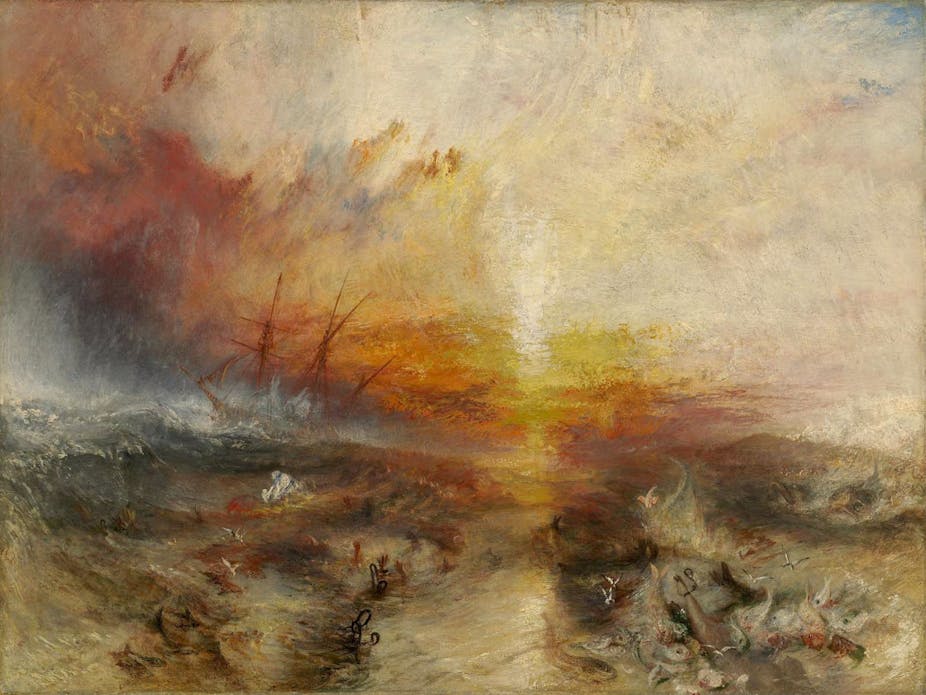In the same week that Charlie Hebdo’s cartoon of Aylan al-Kurdi made the headlines, I’m reminded of another controversial image.
In 1840, J M W Turner exhibited what would become one of his most famous and enduring paintings: slavers throwing overboard the dead and dying – Typhoon coming on. It features a storm-rattled slave ship bubbling in a soup of drowned limbs, gorged upon by carnivorous fish. Accompanying the work were lines of his own poetry:
Hope, Hope, fallacious Hope!
Where is thy market now?
The painting was based on real events; but those events were nearly 60 years old when Turner painted them. The Zong Massacre had occurred way back in 1781. It was something he had read about in a book.
During that time, a sea-change had occurred in British politics. No longer proponents of the once-lucrative trade, Britain had collectively metamorphosed from a nation of slavers to a nation of abolitionists. No longer able to dominate the seas, Britain devoted itself to a new form of global supremacy: one of progressive humanitarianism, or at least the appurtenances thereof.
The painting’s appearance at the Royal Academy coincided with a large anti-slavery meeting at nearby Exeter Hall, presided over by the Prince Consort himself. Viewed in this light, it’s possible to read the painting less as a critique of slavery and more as a tribute to Britain’s revised opinion of itself. Like the slaves of the Zong, slavery itself had been cast out to sea: as Robin Blackburn suggests: “In order to render the ship of state more seaworthy in a storm.”
Almost 250 years after the Zong first made the news, three-year-old Aylan al-Kurdi’s image became a worldwide phenomenon. The result was what appeared to be – again – a change in public opinion. Seemingly overnight, the “migration crisis” became a “refugee crisis”. Offers of help flooded in. It was a case of all hands on deck as even the Daily Mail abruptly, unbelievably, changed tack.
Sea-change. It’s a phrase we use often. We use it to mean a sudden, radical shift: like a shoal of fish suddenly changing direction, moving this way, now that, as one; a single organism with a myriad shimmering scales.
But the idiom “sea-change” means something more permanent than a transient change in direction. The phrase originates in Shakespeare’s The Tempest, where it refers to a shipwrecked death at sea:
Full fathom five thy father lies
Of his bones are coral made
Those are pearls that were his eyes
Nothing of him that doth fade
But doth suffer a sea change
Into something rich and strange.
A “sea-change” here is a sea-wrought alteration; a deep, permanent, almost alchemical transformation from one substance into another – sand into pearl – mortal flesh into precious stone, “rich and strange”.
The phrase washed up again centuries later. In 1917, Ezra Pound wrote in his Cantos of a “sea-fight”:
Full many a fathomed sea-change in the eyes
That sought with him the salt sea victories.
Here the sea-change occurs “in the eyes” – a change, this time, less material and one more of perspective. But Pound understood the power of the image. He was, after all, an imagist – a literary movement wherein “an exact visual image made a total poetic statement”.
The image of Aylan al-Kurdi is not the first graphic image of a dead or dying child to become a “total poetic statement” – statements wherein each element of the image assumes an eloquence of its own, a message clearly articulated and communicated to eyes that are greedy for meaning.
Other notable examples include the image of Omayra Sanchez in 1985 and that of the unnamed starving Sudanese child photographed with a vulture in 1993. The implicated spectator looks on just as the bird looks on, and just as the photographer – Kevin Carter – looked on. Not pornography this, but necrography: the spectacle of death. Carter committed suicide at 33, a year after the picture was taken.

Isn’t our fascination with such images – the power with which we imbue them – as much a reflection of ourselves than of any external reality? Vulture-like, we gorge ourselves on images of the dead, hovering at a distance; inexplicably pleased with ourselves for having the courage to look, and salving our guilt with packages of shoes and toothpaste. And as we move on, satiate, the pictures remain. Their surfaces are impenetrable, fixed forever in time and space.
Today, Turner’s painting hangs in the Museum of Fine Arts in Boston, which purchased the painting in 1899 for $65,000. Aylan al-Kurdi’s image does not hang in a gallery somewhere, but exists everywhere and nowhere, an endlessly repeated trace.
And what of us, then; can we escape memory, and history? Perhaps we can rewrite it, or imagine it is something other than it is; convince ourselves that a sea-change is no more than shoal instinct; silver bellies moving left, then right.
Convinced we were on the “right” side all along, riding waves of compassion, lithe in our wetsuits. But we would do well to remember that a true sea-change is radical in transformation, not just a change “in the eyes”. We are none of us, in death, reducible to an image. And we are none of us, in life, reducible to mere spectators.

